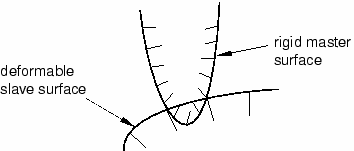Mesh refinement | ||
| ||

- Tie constraints
The tie constraint prevents surfaces initially in contact from penetrating, separating, or sliding relative to one another. It is, therefore, an easy means of mesh refinement. Since any gaps that exist between the two surfaces, however small, will result in nodes that are not tied to the opposite boundary, you must adjust the nodes to ensure that the two surfaces are exactly in contact at the start of the analysis.
The tie constraint formulation constrains translational and, optionally, rotational degrees of freedom. When using tied contact with structural elements, you must ensure that any unconstrained rotations will not cause problems.